Nikkor AF-S DX 18-200mm f/3.5-5.6 G ED VR II review
-
-
Written by Gordon Laing
In depth
Nikkor DX 18-200mm VR II design, build quality and focusing
The Nikkor DX 18-200mm VR II is pictured below on the far right, with the DX 18-105mm VR kit lens in the middle and the DX 16-85mm VR on the left. The DX 18-200mm VR II looks almost identical to its predecessor, with the only external changes being the zoom lock switch on the side, a slightly narrower zoom ring to accommodate the switch, and a swap from red to gold for the VR logo.
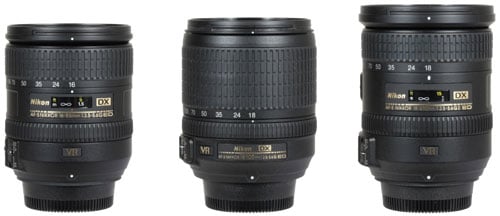 |
Measuring 77mm in diameter and 97mm in length when zoomed-out to its shortest focal length, the DX 18-200mm VR II is exactly the same size as its predecessor. Both are a little larger in each dimension than the DX 18-105mm VR (which measures 76x89mm) and the DX 16-85mm VR (which measures 72x85mm). In terms of size and looks when zoomed-out, the DX 18-200mm VR II is essentially a chunkier version of the DX 16-85mm VR. Zoom all three lenses into their longest focal lengths as seen below though and the 200mm reach of the super-zoom unsurprisingly results in the longest overall barrel extension.
Nikon quotes the DX 18-200mm VR II’s weight as 565g, or 5g heavier than its predecessor, attributable no doubt to the new zoom lock mechanism. Both models feel heftier than the DX 16-85mm VR and DX 18-105mm VR which weigh 485 and 420g respectively. All are clearly much larger and heavier than the DX 18-55mm VR kit lens which measures 73x80mm and weighs just 265g.
The weight of the DX 18-200mm VR II lends it an air of solidity and confidence that can be lacking in lighter lenses, but in terms of build quality, it’s essentially the same as the DX 16-85mm VR.
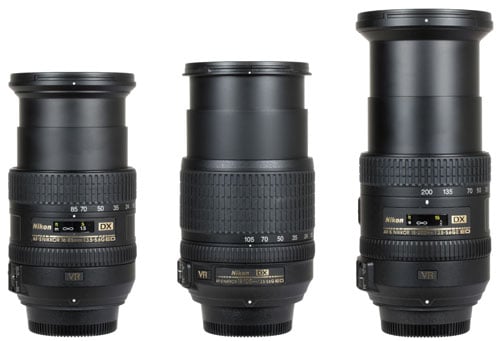 |
As mentioned above, the only major change between the DX 18-200mm VR II and its predecessor is the presence of a zoom lock switch on the side of the barrel. This locks the lens at the 18mm focal length, preventing the barrel from extending during transportation. The extension of a barrel under its own weight when pointing down, or retraction when pointing upwards is known as zoom-creep, and was the major complaint of the original Nikkor super-zoom. While the switch on the new model certainly holds the lens in position, creep is still very much present when unlocked.
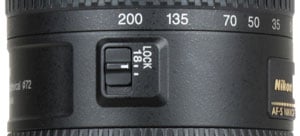 |
But first the good news: when our test sample was fully zoomed out to 18mm, the barrel held in position even when pointed vertically downwards, or mounted on a camera hanging on a strap; likewise when zoomed-in to 200mm and pointed vertically upwards, the barrel again didn’t budge.
But between the focal lengths of 28 and 135mm, our test sample suffered from the same degree of creep as its predecessor. With the lens set within this range, the barrel will extend or retract under its own weight when pointed vertically down or up – and that’s even on a brand new sample with relatively stiff mechanics. To be fair if the lens isn’t vertical, the creep quickly becomes less of an issue, but under the right (or wrong) conditions, you’ll experience it – and we have a demonstration in our HD video tour.
So if you were hoping for a super-zoom lens bereft of creep you’ll be disappointed, but again to be fair, it may rarely be a problem. In our tests it never occurred with the lens fully zoomed in or out, and of course the new lock switch will ensure the barrel remains in place while being transported or carried on a strap. Somewhat perversely though you may find yourself leaving it unlocked more often than not, as it can be annoying to find the zoom ring locked when you want to quickly twist it to a longer focal length to grab a photo opportunity. Indeed it slightly defeats the convenience and speed of the lens when you have to remember to unlock it before use, but again Nikon’s provided the facility should you want to use it. As a final postscript, it’s also worth noting creep is equally a problem for other super-zooms, including Canon’s EF-S 18-200mm IS, which coincidentally also offers a lock at 18mm.
The weight of the optical elements which cause creep in the first place can also be felt when twisting the zoom ring. If the lens is pointing upwards, you’ll need to apply more force to twist the zoom ring than most models, but the operation is fairly smooth and you’ll easily be able to make small adjustments where desired.
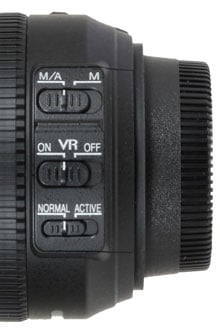 | |
|---|---|
Towards the lens mount is a thin manual focusing ring which offers full-time adjustments and doesn’t rotate during autofocusing. Between it and the zoom ring is a focus distance window. The filter mount measures 72mm and also doesn’t rotate while focusing which will come as a relief to users of polarising or graduated filters.
Like its predecessor, there’s three switches on the side of the barrel. One switches the camera between AF with full-time manual focusing, or manual focusing only. The second switches the VR system on or off, while the third sets the VR between Normal and Active modes. We’ll examine the VR capabilities on the Features page.
The metal lens mount features a rubber ring to provide some degree of environmental sealing – it’s far from being water-proof, but it’ll help prevent dust and moisture from entering the body, or indeed the rear of the lens. Like most of its lenses, Nikon also supplies the DX 18-200mm VR II with a hood and pouch.
It’s interesting at this point to compare the Nikkor DX 18-200mm VR II against the Canon EF-S 18-200mm IS. Both lenses share the same actual focal range and aperture, but the Nikkor model manages to outclass its rival in a number of subtle respects. The EF-S 18-200mm IS doesn’t have Canon’s quiet focusing motor, the manual focusing ring rotates while autofocusing, there’s no focus distance window, no rubber ring on the lens mount, and like all non-L Canon lenses, no hood or pouch supplied as standard. But in its favour, the Canon super-zoom is typically 20% cheaper. It’s revealing to see the direction each company has taken with what could have been virtually identical lenses.
Nikkor DX 18-200mm VR II out-of-focus effects | Nikkor DX 18-200mm VR II shadow from popup flash | |
 |  | |
DX 18-200mm VR II at 200mm, 33% crop | DX 18-200mm VR II at 18mm with Nikon D90 popup flash (distance 2m) |
Before wrapping-up this section, we have a couple of quick notes concerning bokeh and flash clearance. In the image above left, you can see typical out-of-focus effects from sunlight reflecting on rippling water, reproduced here at 33%. The bokeh here is par-for-the-course on a lens of this type, and you can see an example of a portrait with an out-of-focus background in our sample images gallery.
Above right is a full-size image showing the shadow cast by the relatively large lens barrel when fully zoomed-out at a distance of 2m and using the popup flash on a Nikon D90 body. Unsurprisingly given its size, the DX 18-200mmm VR II will cast a small shadow when zoomed-out to 18mm and used with popup flashes, but zooming-into 26mm and beyond will eliminate it. So if you’re taking group shots at close range with a popup flash, try zooming-in a little to avoid casting a shadow at the bottom of the frame.
Nikkor DX 18-200mm VR II optical design
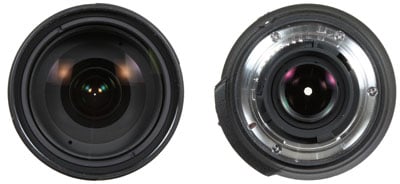 | |
The Nikkor DX 18-200mm VR II shares the same optical construction as its predecessor with 16 elements in 12 groups, with two ED glass and three aspherical elements. Nikon claims to have improved the coatings on the new lens, but we couldn’t confirm that in practice. As far as we’re concerned, the optical construction and quality is essentially the same on both versions.
The focal ratio remains f3.5 when zoomed-out to 18mm and f5.6 when zoomed-in to 200mm, and the aperture again employs seven rounded blades; you can see an example portrait shot with the aperture wide open in our sample images gallery. The closest focusing distance is 50cm throughout the focal range and again we have an example in our gallery.
The focal ratio slows down fairly quickly in the range as indicated by maximum aperture at the following focal lengths we tested: f4.2 at 35mm, f4.8 at 55mm, f5.3 at 85mm and f5.6 at 135mm.
Nikkor DX 18-200mm VR II focusing
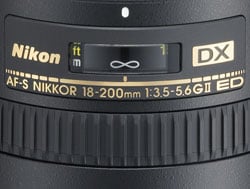 |
The Nikkor DX 18-200mm VR II is an AF-S model, which in Nikon’s terminology means it’s equipped with a Silent Wave Motor (SWM) for autofocusing. Since the focusing motor is built-into the lens, it will autofocus on any of Nikon’s DSLRs, including the budget models which don’t feature their own AF motor for driving older, non AF-S lenses.
AF-S lenses also have the potential to be quick and quiet, although don’t assume all are equal in these respects. In use the DX 18-200mm VR II’s autofocusing may have been pretty quiet, but it was fairly leisurely in speed, taking around 1.2 seconds to go from infinity to 50cm and back again – you can see and hear this in action in our HD video tour. But while it’s far from the fastest focuser in the Nikkor catalogue, we rarely found its speed limiting in general-use, with the lens generally locking-onto subjects in fair light without any searching.
Once again, we’re pleased to report that neither the manual focusing ring nor the filter mount rotate while autofocusing. Now let’s take a look at the coverage and stabilisation in our Nikkor DX 18-200mm VR II features page.
Nikkor DX 18-200mm VR II coverage and stabilisation
Nikkor DX 18-200mm VR II coverage | ||
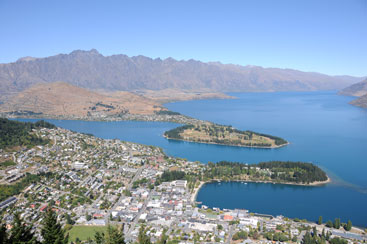 |  | |
DX 18-200mm VR II at 18mm (27mm equivalent) | DX 18-200mm VR II at 200mm (300mm equivalent) | |
It’s clear from the images above the degree of flexibility such a lens provides. You could be shooting an expansive landscape at one moment, spot an unusual bird or animal in the distance and within a second or two twist the zoom ring around to capture a tight close-up view. Such a range is equally useful when shooting in urban environments, allowing you to capture wide architectural views, before zooming-in for some interesting street shots. Suffice it to say the ability to zoom from wide to decent telephoto is also ideal when you’re attending weddings or sporting events.
Of course you can achieve the same range with multiple lenses, and also generally enjoy superior performance while you’re at it, but the convenience of having it all in one lens cannot be underestimated. You don’t need to lug multiple lenses around with you, waste time changing them while running the risk of missing your photo opportunity, and of course by not removing lenses, you’ll also minimise the risk of dust entering the body. All these reasons make super-zooms ideal for travel photography, and are responsible for them topping the best-sellers lists.
Once again, going for multiple lenses provides the opportunity to buy specialist models which may be wider, longer, sharper, brighter or quicker, but for many people, a 27-300mm equivalent range could be all they ever need. It’s certainly a compelling prospect.
If you’re upgrading to the DX 18-200mm VR II from a typical Nikkor kit lens, the wide angle coverage will be essentially the same when zoomed-out, but of course the big difference is when you’re zoomed-in. To illustrate the difference you can expect in practice we’ve taken photos with the DX 18-55mm VR and DX 18-105mm VR kit lenses when each is fully zoomed-in, then superimposed a frame indicating the relative coverage of the DX 18-200mm VR II when it’s zoomed all the way in. To generate these frames, we superimposed actual images taken with the DX 18-200mm VR II and reduced their size until the details matched. As such, the images below illustrate the exact differences you’ll experience.
Nikkor DX 18-200mm VR II telephoto coverage comparison | ||
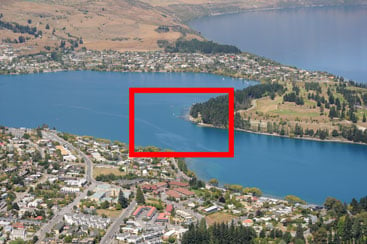 | 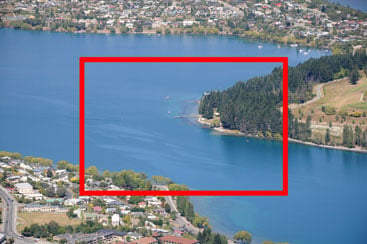 | |
DX 18-55mm VR at 55mm (82.5mm equivalent) Red frame represents actual coverage of DX 18-200mm VR II at 200mm | DX 18-105mm VR at 105mm (157.5mm equivalent) Red frame represents actual coverage of DX 18-200mm VR II at 200mm | |
As seen above left, DX 18-200mm VR II can capture a significantly smaller area than the DX 18-55mm VR kit lens, and represents a big step-up in power over that model. The difference with the DX 18-105mm VR above right though may not seem as great as you perhaps expected, and it’s even less so when compared against the older DX 18-135mm kit lens. It still represents a healthy boost in magnification, but owners of these lenses may prefer complementing them with the AF-S 70-300mm VR for greater power.
When discussing optical ranges, especially on super-zoom models, it’s also important to consider the focusing distance. Lenses that employ internal focusing systems can suffer from an optical effect known as shrinkage, where the effective focal length actually decreases at closer focusing distances. This effect applies more for zoom lenses and particularly those with long zoom ranges. This is why all manufacturers calculate and quote focal lengths with the lenses focused at infinity, as the range could actually be noticeably lower when focused on closer subjects.
We’ve previously discussed the effect of zoom shrinkage in this article, while our forum moderator Thomas delved into the technicalities in this forum post, but for the first time we’re now going to illustrate the impact in one of our reviews.
Below are the coverage shots you saw earlier with the lens focused at infinity. This time we’ve superimposed the image taken at 200mm over the one taken at 18mm and shrunk it until the details matched. We then used this to create a frame to indicate the relative coverage. So the red frame you see below left indicates the area captured by the lens when zoomed-into 200mm. If you were to place similar frames corner-to-corner, you’d find the effective range was close to the 11.1x as expected.
Nikkor DX 18-200mm VR II coverage when focused at infinity | ||
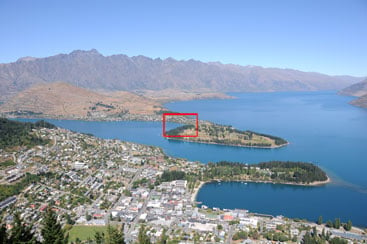 |  | |
DX 18-200mm VR II at 18mm (27mm equivalent) | DX 18-200mm VR II at 200mm (300mm equivalent) | |
So far so good, but now let’s see what happens at the closest focusing distance of 50cm. As before we took two photos from the same tripod-mounted position, first at 18mm, and secondly at 200mm. Once again we superimposed the 200mm image over the 18mm version and shrunk it until the details lined-up; this was then used to generate the green frame you see below left.
Nikkor DX 18-200mm VR II coverage when focused at 50cm | ||
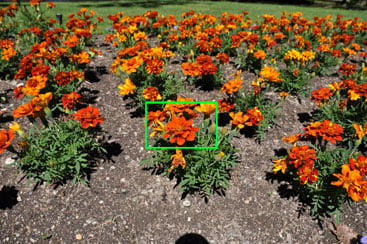 |  | |
DX 18-200mm VR II at 18mm (27mm equivalent) | DX 18-200mm VR II at 200mm (equivalent here to approx 200mm) | |
As before this frame represents the coverage you’d achieve with the lens zoomed-into its maximum focal length, but already you can see it’s a larger area than on the examples taken at infinity. Indeed if you placed multiple copies of this frame corner-to-corner you’d discover the range had shrunk to six or seven times. As such when focused at close-range, the DX 18-200mm VR II actually acts more like an 18-135mm lens.
If you’ve not come across this effect before, you’ll probably be suprised at this point, but as mentioned at the start, it affects all lenses with internal focusing, especially zooms, and particularly those with super-zoom ranges. It’s not just Nikon or this lens. Some optical designs suffer more than others, but it’s an issue which faces most zooms. By sharing the same optical construction as its predecessor, the zoom shrinkage of the DX 18-200mm VR II is no worse, but as illustrated above, it’s certainly noticeable and will impact anyone who shoots subjects at close range, such as portraits and especially macro images.
 |
Nikkor DX 18-200mm VR II Stabilisation
The Nikkor DX 18-200mm VR II is equipped with Vibration Reduction (VR) capabilities to counteract camera shake. Like all Nikkor VR lenses to date, this employs an optical system which means you see the stabilising effect while composing through the optical viewfinder.
Seeing the image suddenly steady itself when you half-press the shutter release button is very reassuring, especially when you’re shooting at longer focal lengths.
VR is enabled by flicking a switch on the side of the lens barrel. Nikon claims the lens has four stops of compensation and like many VR models there’s the choice of Normal or Active modes, the latter designed for photographing from a moving vehicle.
To put its effectiveness to the test we took a series of photos with it zoomed-into an equivalent of 300mm, where traditional photographic advice would recommend a shutter speed of at least 1/300 to eliminate camera shake.
Our sequence started at 1/320 and reduced by one stop each time until 1/10. We performed this sequence twice, first without VR enabled, and secondly with VR enabled. Below are 100% crops taken from the non-VR and VR images at a shutter speed of 1/20.
Nikkor DX 18-200mm VR II Vibration Reduction | ||
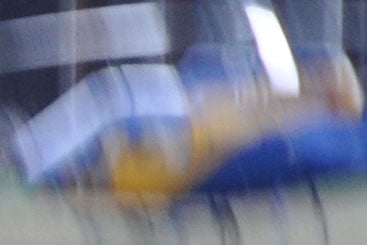 | 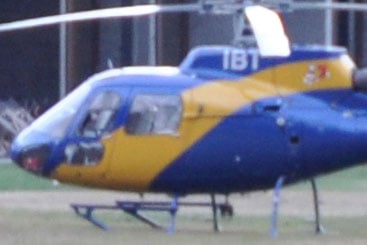 | |
DX 18-200mm VR II at 200mm (300mm equivalent) VR off, 1/20 | DX 18-200mm VR II at 200mm (300mm equivalent) VR on, 1/20 | |
On the conditions of the day, the fastest we could handhold a sharp result when fully zoomed-in without any stabilisation was at 1/320; anything slower suffered from camera shake. With VR enabled, we could match the sharpness under the same conditions at a shutter speed of 1/40, although the result at 1/20 was almost as good. You can see examples taken at 1/20 with and without stabilisation above, and it’s clear how the version with VR is much steadier.
This corresponds to between three and four stops over our 1/320 shot in practice, which just about meets Nikon’s claim of four stops of compensation. It’s certainly a very useful facility to have at your disposal and makes handholding the DX 18-200mm VR II quite possible even at its longest focal length in modest to low light.
Now it’s time to see how the lens performs against alternative general purpose zooms in our Nikkor DX 18-200mm VR II results pages.




